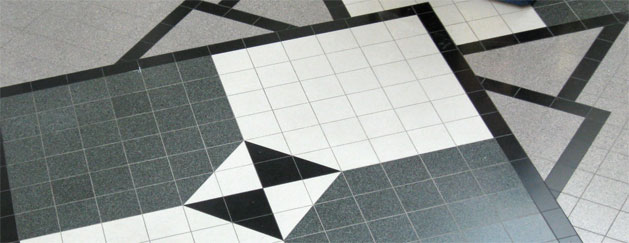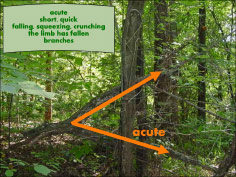
Students will learn the different types of angles, identify them in photographs, and write cinquain poems that share angles they find in the world around them.
Apps: Wixie®

Math is more than functions and theorems. Your task is to create a coffee table book of poetry that not only shows what you know about the properties of angles, but helps others see the beauty of math in the world around you.
Read some of the math poems in Marvelous Math by Lee Bennett Hopkins and Karen Barbour, especially the poems on angles. Introduce different types of angles (acute, obtuse, right, and straight) to your students.
Share a list of vocabulary related to angles. Include words like acute, obtuse, right, straight, ray, and vertex. Ask students to help you write simple definitions for each, such as:
If these terms are new to your students, divide the class into small teams and have each team quickly work to define one of the terms using a textbook or math glossary. Have teams share their definitions with the larger class.
Once students understand the different types of angles, have them demonstrate their understanding of the definition by using a digital camera, tablet, smart phone, or a web search to capture and collect images of angles in the world around them. Start by having them capture images of individual acute, obtuse, and right angles, and then encourage them to capture or find images that contain multiple angles.
Initially students may find it difficult to identify multiple angles in the same picture, but it doesn't take long for them to discover that when they find one angle, they often find its supplement! You can help them make this connection by sharing examples where one of the rays of an angle can continue past the vertex.
Students can open their images in Wixie and draw angles on the images using the arrow shape in the paint tools. They should also add text captions to label each angle. Let them know they will need to save room to add a math poem.
Introduce students to the cinquain form of poetry. Cinquain (pronounced "cin-kain") is a five-line poetic form, using a wavelike syllable count of two-four-six-eight-two.
Let them know that they need to become mathematical poets and write cinquains that represent what they have learned about the angle, or angles, represented in their picture. Encourage them to write poems that reflect the image and angles as one entity.
Have students share their rough draft with a few peers who can read it and provide input on both its accuracy and the effectiveness of the word choices. Once students have made edits, have them add the poem to their Pixie or Wixie page. Have them recite the poem using the recording feature. This is useful for helping them work through problems they are having with determining the correct number of syllables.
Print each student page (including both the photograph and poem) and bind them into a class book you can share in your library or school media center. You might also consider exporting each image as a JPG file and then creating a more professional-looking photo book you could share in a local coffee shop or as a coffee table book in the school office.
You can also import all student pages into one project to create a video you can share on your school web site or YouTube. You can also export their combined work as a PDF or ePub for easy viewing on tablets as an additional classroom resource for review.

Assess prior knowledge as you discuss the definitions of different types of angles and angle vocabulary. Walk around and talk with students as they use a digital camera, tablet, smart phone, or a web search to capture and collect images that include different angles. Have them point out the angles to you so you can quickly identify misconceptions and confusion with terminology.
Instead of asking for a text definition, this activity asks students to provide a visual example. As they work to use the paint tools to identify the angles, check to see that the angles are correctly identified and labeled. You may even want to give extra credit to students who capture an image that includes more than one type of angle.
The cinquain poem is an opportunity for students to play with the definition. What infinitives (words ending in -ing) are they choosing? This will give you a window into their comprehension as well as their facility with language.
You can also have young students capture and identify basic shapes such as circles, squares, and triangles. Playground equipment is a great place for them to find these shapes. Have more advanced students identify complex shapes such as rhombuses and trapezoids as well as examples of complementary and supplementary angles.
Lee Bennett Hopkins and Karen Barbour. Marvelous Math: A Book of Poems.
ISBN: 0689844425
Laura Meiselman. What's Your Angle? And 9 More Math Games.
ISBN: 0439437628
Hamilton's Math to Build On: Angles
Mathematics: Geometry
4.A.1. Draw points, lines, line segments, rays, angles (right, acute, obtuse), and perpendicular and parallel lines. Identify these in two-dimensional figures.
English Language Arts: Language
4.3.Use knowledge of language and its conventions when writing, speaking, reading, or listening.
a. Choose words and phrases to convey ideas precisely.
English Language Arts: Writing
4.4 Produce clear and coherent writing in which the development and organization are appropriate to task, purpose, and audience.
6. Creative Communicator
Students communicate clearly and express themselves creatively for a variety of purposes using the platforms, tools, styles, formats and digital media appropriate to their goals. Students:
a. choose the appropriate platforms and tools for meeting the desired objectives of their creation or communication.
b. create original works or responsibly repurpose or remix digital resources into new creations.
d. publish or present content that customizes the message and medium for their intended audiences.

Follow us on Instagram for daily inspiration

Create a thought web, cluster, flowchart, or other graphic organizer for a lesson
8 first projects to get students using technology
Creative, digital book reviews
Fun and powerful ideas with animated characters

Wixie
Share your ideas, imagination, and understanding through writing, art, voice, and video.

Rubric Maker
Create custom rubrics for your classroom.

Pics4Learning
A curated, copyright-friendly image library that is safe and free for education.

Wriddle
Write, record, and illustrate a sentence.

Get creative classroom ideas delivered straight to your inbox once a month.
Topics